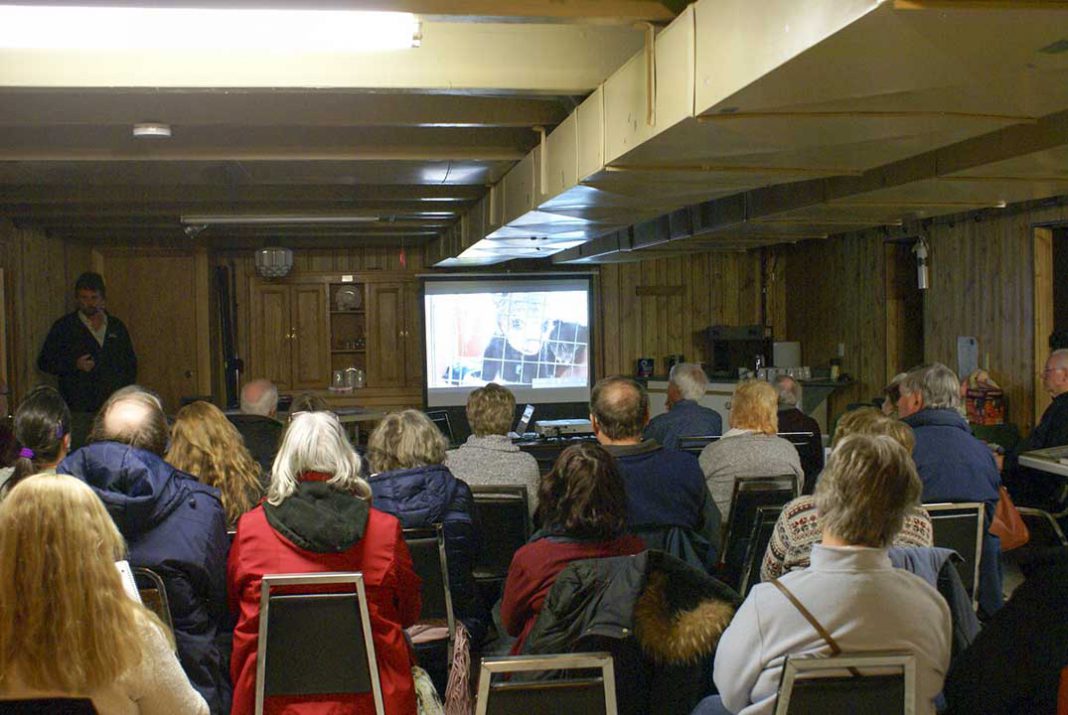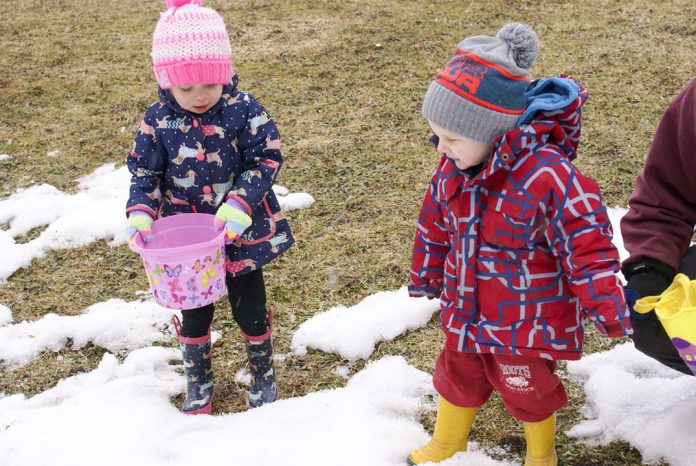MINDEMOYA––Mike McIntosh has been helping black bears for more than 25 years at the Bear With Us Sanctuary and Rehabilitation Centre for Bears located in Sprucedale, Ontario.
Mr. McIntosh was raised on a farm in southwestern Ontario and has always been interested in wildlife and the natural environment. As a post-secondary student, he was initially interested in bears and wolves. “I read every book I could find on bears,” he explained. “From one book to the next the facts were polar opposites. I wanted to find out the truth and spread the message.”
Mr. McIntosh was in Mindemoya last Friday at a presentation hosted by the Manitoulin Nature Club. He believes that educating people is critical to assisting bears and people to coexist. It was a packed house at St. Francis of Assisi Anglican Church, proving that he isn’t the only one intrigued by these intelligent and amazing creatures.
In 1991, Mr. McIntosh approached the Ministry of Natural Resources (MNR), offering to help orphaned cubs and injured bears and also to assist the public with nuisance bears, although he prefers the term “human-bear conflict resolution.” In 1992, with the help of some friends and the cooperation of the MNR, he opened the sanctuary. The first bear arrived in April 1992. It was “a big old blind bear from a zoo in eastern Ontario,” who remained at Bear With Us until his passing. Since its inception, Mr. McIntosh and Bear With Us has assisted more than 530 orphaned and injured bears return to the wild. The sanctuary provides a permanent home to a select few bears that are unable to return to the wild. You could say he knows a thing or two about bears.
The first thing he wants people to know is that black bears rarely attack people. “There have been people attacked by mother bears with cubs,” he acknowledged, “but almost always those attacks involve a dog off-leash. A dog on a leash is a deterrent but off-leash can cause an altercation.”
Bears are omnivores. This means they eat whatever they can get their paws on but they are primarily vegetarian. “They do almost everything they can to avoid contact with people,” said Mr. McIntosh, “and they don’t attack children. In 116 years of record keeping in North America there has only been one case of a child attacked by a black bear, and that child was 10-years-old. Black bears can detect a threat and they know a small child does not present a threat.”
In fact, full-blown attacks by black bears are rare, according to Bear With Us, “killing fewer than one person every three years on average, despite hundreds of thousands of encounters.” To put this in perspective, data from the United States National Center for Health Statistics shows that between 1980 and 1983, for each death from a black bear across North America, there were approximately 17 deaths from spiders, 25 deaths from snakes, 67 deaths from dogs, 150 deaths from tornadoes, 180 deaths from bees and wasps, 374 deaths from lightning and 90,000 homicides in the United States alone.
Cubs are generally born in January weighing only 227 to 450 grams and are quite helpless. Their eyes don’t open for about eight weeks. They will emerge from the den in late April to early May. The first thing the mother bear does on emergence is to locate a sanctuary tree. The cubs learn to walk, gain strength, and then climb the tree. Mama bear leaves the cubs in the tree while she forages on her own. Every few hours she will return to nurse and then go look for food again.
Bears don’t come out of the den ravenously hungry. They don’t use much energy over the winter and still have large fat stores when they emerge. They will lose weight until more calorie-dense foods such as berries are available. By the end of July a bear will lose approximately one-third of its body weight. “A bear’s life is really all about food,” explained Mr. McIntosh. During the berry season a bear will eat up to 24 hours a day, taking in up to 20,000 calories and gaining two to three kilograms per day in preparation for winter. “A bear’s hibernation period lasts four to five months. It takes them three to four months to prepare.”
While it appears that bears are solitary animals they are really quite social. The appearance is largely due to the intense foraging. In one of his first winters with the sanctuary, Mr. McIntosh built four dens (plywood boxes filled with straw) to provide shelter during the winter. There were 20 bears that winter. “All 20 went into one enclosure,” he said. Now he builds one enclosure that is large enough for the number of bears in that enclosure.
A mother bear will have one to three cubs, although three is rare. She will often keep a yearling with her and the new cubs. Sometimes bears will adopt orphan or less thriving cubs. Adoptions generally occur within families. Family breakups can be painful, particularly for the cubs. “Sometimes the mother bear will have to beat the cubs to make them go away,” said Mr. McIntosh, “and siblings will often stay together.”
When not hibernating bears do play. There is another misconception Mr. McIntosh wants people to know. “Happy bears are silent,” he said, “and bears don’t growl.” They do make noises, but documentaries that show bears growling and snarling at each other have dubbed in sounds, “usually a blend of lions and dogs growling,” he said. Bears will snort, stomp and spray. “They have a deep moan,” said Mr. McIntosh. “When black bears are nervous they clack their jaws and moan. They’re scared and not dangerous. They’re all bluff and bluster.”
Still, he warned, you should never intentionally approach a bear. “Bears are a part of the natural environment,” he continued. “They are not a nuisance and should be respected. Never purposely feed or try to approach a bear. Relocation is a last resort; it’s a poor way to prevent conflicts with bears.” It is better to put your bird feeders away, to keep your food in bear-proof containers and to put your garbage out the morning of collection.
If you do encounter a bear unexpectedly, Mr. McIntosh recommends that you stay still, speak to the bear in a calm voice, and ensure the bear has a clear escape route. Do not wave your arms, shout, run or climb a tree. Almost always the bear will retreat, he said. Keep bears away from your livestock or feed with an electric fence. “One strand around the outside of enclosures will keep wild bears out,” he said. “We don’t always have to destroy or adversely affect wildlife.”
The Bear With Us Sanctuary and Rehabilitation Centre for Bears is a registered charity and receives no government funding. They minimize human exposure to the bears with only Mr. McIntosh and one other person having regular access to the enclosures. Learn more about black bears and the sanctuary by visiting www.bearwithus.org.





